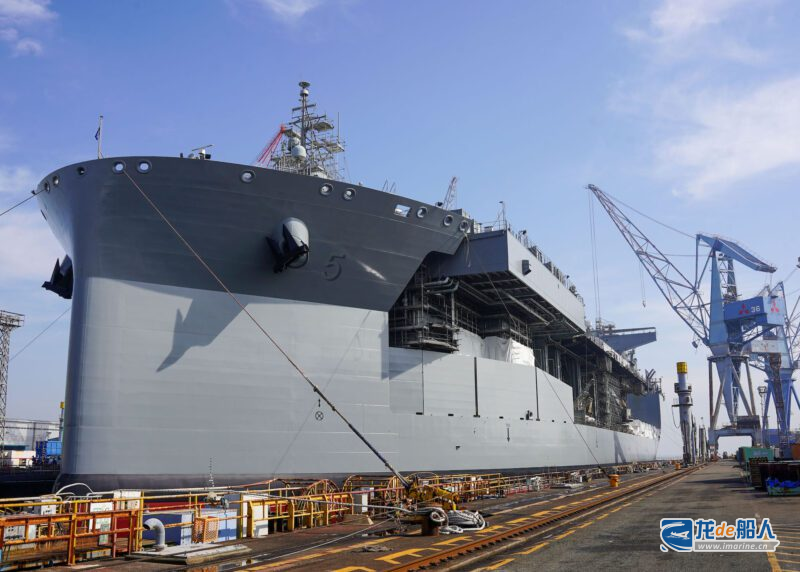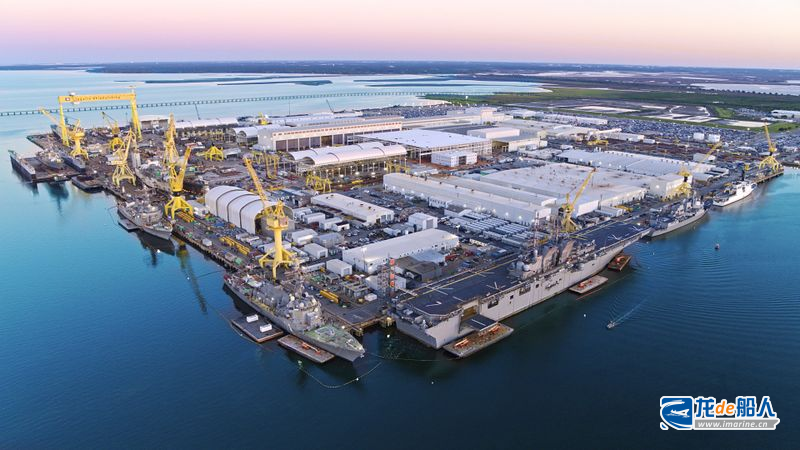As the U.S. aggressively pushes ahead with its shipbuilding revival, its shipbuilding allies South Korea and Japan have announced investments in the U.S. shipbuilding industry.

The domestic shipbuilding industry is in dire straits, and Japan is pouring money into helping the U.S.
As the U.S. is aggressively promoting a shipbuilding revival, its shipbuilding allies South Korea and Japan have announced investments in the U.S. shipbuilding industry.
On July 23, the White House announced that the U.S. and Japan had reached a new trade agreement on that day, under which Japan would provide the United States with US$550 billion in investment and loans, focusing on key industries such as shipbuilding.
According to a briefing released by the White House, Japanese shipbuilders’ investments include both commercial and defense shipbuilding in the U.S., including new shipyards and modernization of existing shipyard facilities. In recent months, the U.S. and Japan have discussed the U.S.-Japan Shipbuilding Revitalization Fund, with Japan proposing to build car carriers and LNG carriers and invest in U.S. shipyards.
White House press secretary Karoline Leavitt confirmed that Japan’s huge investment and loans will be used at the discretion of U.S. President Trump, and the investment areas include energy, semiconductors, critical minerals, pharmaceuticals and shipbuilding.
This U.S.-Japan trade agreement echoes the statement made by U.S. Navy Secretary John Phelan during his visit to Japan in April this year regarding the “necessity of establishing shipbuilding capabilities outside of China.”
During his visit, John Phelan stated, “The goal should be: How can we establish production capacity outside of China? How can we begin to establish critical production capacity in strategic areas in the U.S.?” He also emphasized that icebreakers and liquefied natural gas (LNG) carriers would be potential projects for cooperation with the shipbuilding industries of South Korea and Japan.
Under the trade agreement signed on the 23rd, tariffs on Japanese automobile imports will also be reduced, and Tokyo will be exempt from new tariffs on other goods threatened by the global tariffs announced by the Trump administration in April.
Although the U.S. has made Japan one of its shipbuilding allies, the current state of Japan’s shipbuilding industry is also worrying, with long-established shipbuilding companies such as Mitsui E&S Holdings, Sasebo Heavy Industries, and Sumitomo Heavy Industries withdrawing from the shipbuilding industry.
Japanese shipyards, which once dominated the global shipbuilding market, have seen their market share shrunk significantly, with the vast majority of orders now being received by China (70% of the world’s new shipbuilding capacity and 90% of its repair capacity) and South Korea (its long-time regional rival). Clarksons data shows that Chinese shipyards account for 69% of new ship orders in 2024, South Korea accounts for 15%, and Japan accounts for only 7%.
In order to revitalize the shipbuilding industry, the Japanese government announced earlier that it plans to double shipbuilding output by 2030 and restore its market share to 20%.
According to Japan’s shipbuilding revitalization plan, it is proposed to encourage shipbuilders to restore idle shipbuilding and maintenance facilities; encourage public and private investment in the next generation of shipyard infrastructure, including the establishment of a government-supported national shipyard; plan to set up a fund to raise 1 trillion yen for equipment investment; promote the use of digital technology to improve the efficiency of ship development, design, and construction; improve the talent training base, allow more foreign workers to enter the Japanese shipbuilding industry and provide them with training, etc.
Coincidentally, major Korean shipbuilding companies have reached a number of cooperation agreements with the United States.
As a long-time competitor of Japanese shipyards, South Korea, another high-profile shipbuilding ally of the U.S., is stepping up its investment in the American shipbuilding industry.
The just-announced new U.S.-Japan trade deal comes on the heels of Hanwha Philly Shipyard’s historic order for 1+1 LNG carriers, the first LNG carriers built in the U.S. in 45 years with export viability.
The order was placed by Hanwha Shipping, a U.S. shipping company under Hanwha Group, and the project will adopt a joint construction model, with Hanwha Philly Shipyard responsible for signing the main shipbuilding contract and cooperating with Hanwha Ocean to execute it. Although a “substantial portion” of the construction work will be carried out at Hanwha Ocean’s Geoje Shipyard in South Korea, Hanwha Philly Shipyard will be responsible for US regulatory compliance and safety certification.
In addition to its new shipbuilding plans, Hanwha Shipping also plans to re-flag LNG carriers built at Korean shipyards to the U.S. flag. The plan will utilize the Alternative Compliance Program (ACP) agreed upon by the U.S. Coast Guard and some classification societies for inspection and certification.
According to reports, Hanwha Philly Shipyard was acquired and renamed by Hanwha Group at the end of 2024, marking a landmark event in South Korean shipbuilders’ entry into the U.S. shipbuilding industry, while also aligning with the group’s global expansion strategy. Through this acquisition, Hanwha Group is not only targeting the U.S. commercial shipping market but also the U.S. Navy ship repair and construction market.
South Korea’s largest shipbuilding group, HD Hyundai, is also committed to entering the U.S. shipbuilding industry. For example, HD Hyundai has signed a strategic shipbuilding cooperation agreement with Edison Chouest Offshore (ECO) in the U.S., and the two sides will cooperate in the construction of medium-sized LNG dual-fuel container ships in the U.S.
Under the agreement, ECO will be responsible for the main construction of LNG dual-fuel container ships. HD Hyundai will provide support in the form of ship design support, equipment procurement services, construction technical assistance, and delivery of some hull sections, and will further contribute by investing in key technical assets. Through this cooperation, the two parties aim to gradually expand their cooperation to other areas such as icebreakers, naval ships and cranes.
HD Hyundai believes that this move is intended to actively support the U.S.’ efforts to revitalize its shipbuilding industry and strengthen national security, significantly enhancing the U.S.’ competitiveness in the global shipbuilding sector. In the shipbuilding and maritime transportation sectors, HD Hyundai’s collaboration with U.S. companies extends far beyond this initiative.
In April this year, HD Hyundai signed commercial agreements with Huntington Ingalls Industries (HII), the largest defense shipbuilding company in the U.S., and Fairbanks Morse Defense, a key supplier of defense-related equipment. In July last year, HD Hyundai signed a memorandum of understanding (MoU) on educational cooperation with the University of Michigan and Seoul National University, with the aim of cultivating talent for the shipbuilding industry.

With its internal foundations shaken, can the shipbuilding alliance achieve results?
Although Japan and South Korea have claimed the title of “important partners in the revival of shipbuilding” in the U.S., the internal foundation of the U.S. government that promoted this shipbuilding alliance has actually collapsed.
Recently, there are reports that the newly established shipbuilding office under the National Security Council (NSC) of the White House has become a mere decoration due to personnel transfers, and the core positions are currently vacant. This means that the ambitious shipbuilding revival plan proposed by U.S. President Trump is said to have actually stagnated, and his “shipbuilding revival dream” may be dead in name only.
Meanwhile, Mike Waltz, former U.S. National Security Advisor who was responsible for U.S. shipbuilding and shipping policy and led the drafting of the SHIPS for America Act, has been dismissed due to a military secrets leak incident (Signal Gate). This is another blow to the reform and development of the U.S. shipbuilding industry.
A local shipbuilding expert familiar with Washington’s political arena commented: “Although the Trump administration verbally calls for a ‘renaissance in the shipbuilding industry’, it is actually destroying the basis for its implementation.”
As for its allies South Korea and Japan, although both countries have loudly announced their intention to help develop the U.S. shipbuilding industry, they each have their own limitations. Japanese shipyards are no longer as competitive as they once were, while South Korean shipyards are constrained by capacity and human resources.


